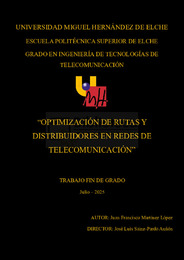Título :
Optimización de rutas y distribuidores en redes de telecomunicación |
Autor :
Martínez López, Juan Francisco |
Tutor:
Sainz-Pardo Auñón, José Luis |
Editor :
Universidad Miguel Hernández de Elche |
Departamento:
Departamentos de la UMH::Ingeniería de Comunicaciones |
Fecha de publicación:
2025-07 |
URI :
https://hdl.handle.net/11000/37533 |
Resumen :
En la actualidad, la rapidez de acceso a diversos sitios web y la ubicación óptima de los servidores son prioridades fundamentales para cualquier proveedor de servicios de Internet (ISP). En este contexto, resulta crucial analizar la cantidad de equipos o nodos por los que deben transitar los datos, tanto en la ruta de ida como en la de vuelta, debido a que cada equipo intermedio que forme parte puede incrementar el retardo en términos de latencia y los costes operativos de la red en relación con la cantidad de saltos hasta llegar al destino.
Este proyecto se centra en el desarrollo e innovación de varios algoritmos de optimización de rutas y switches, con el objetivo principal de minimizar el coste de ambos. Se considera que los interruptores, conmutadores o switches son aquellos nodos con más de dos conexiones, y su reducción contribuye a abaratar la topología de la red en términos operativos, favoreciendo el uso de dispositivos con una entrada y una única salida que actúan únicamente como puntos de tránsito masivo de datos.
Para validar estos algoritmos, se han realizado simulaciones utilizando instancias de grafos estructurados. Los resultados obtenidos permiten evaluar de manera cuantitativa el impacto de cada variante del algoritmo en términos de coste total. Se ha observado que algunas adaptaciones heurísticas y el enfoque genético proporcionan mejoras significativas frente a la versión clásica del algoritmo de Prim añadiendo la variable del coste por disponer de un switch en el árbol.
Estos estudios revelan que, en entornos con alta complejidad y grandes volúmenes de datos, la estrategia genético-heurística resulta particularmente efectiva. En este sentido, el proyecto abre nuevas líneas de investigación para la integración de estas técnicas en entornos reales de redes de telecomunicaciones y para la aplicación de métodos avanzados de paralelización y optimización algorítmica.
Currently, the speed of access to various websites and the optimal placement of servers are key priorities for any Internet Service Provider (ISP). In this context, it is crucial to analyse the number of hosts or nodes through which the data must pass, both on the outgoing and on the return route, because each intermediate host that is part of it can increase the delay in terms of latency and the operational costs of the network in relation to the number of hops to reach the destination.
This project focuses on the development of several route‐ and switch‐optimization algorithms, with the primary goal of minimizing the number of switches required in the network. Switches are defined as those nodes with more than two connections, and reducing their number helps lower the network’s operational topology costs by favoring the use of devices with a single input and a single output that serve solely as high‐volume data transit points.
To validate these algorithms, simulations have been carried out using instances of structured networks. The results obtained allow a quantitative evaluation of the impact of each variant of the algorithm in terms of total cost. It has been observed that some heuristic adaptations and the genetic approach provide significant improvements over the classical version of Prim's algorithm by adding the variable of the cost of having a switch in the tree.
These studies reveal that, in environments with high complexity and large volumes of data, the genetic-heuristic strategy is particularly effective. In this sense, the project opens up new lines of research for the integration of these techniques in real telecommunications network environments and for the application of advanced parallelisation and algorithmic optimisation methods.
|
Palabras clave/Materias:
rutas
distribuidores
algoritmos
adaptaciones de PRIM
métodos heurísticos |
Área de conocimiento :
CDU: Ciencias aplicadas: Ingeniería. Tecnología |
Tipo de documento :
info:eu-repo/semantics/bachelorThesis |
Derechos de acceso:
info:eu-repo/semantics/openAccess
Attribution-NonCommercial-NoDerivatives 4.0 Internacional |
Aparece en las colecciones:
TFG- Ingeniería de Tecnologías de Telecomunicación
|
 La licencia se describe como: Atribución-NonComercial-NoDerivada 4.0 Internacional.
La licencia se describe como: Atribución-NonComercial-NoDerivada 4.0 Internacional.
.png)
